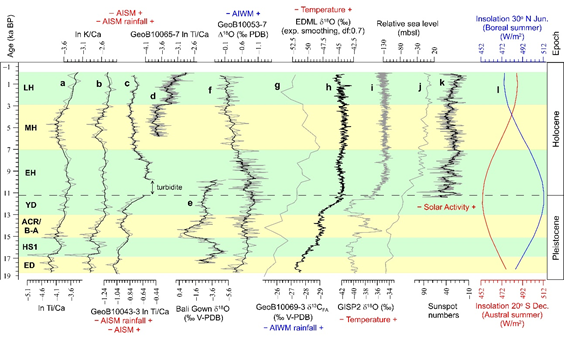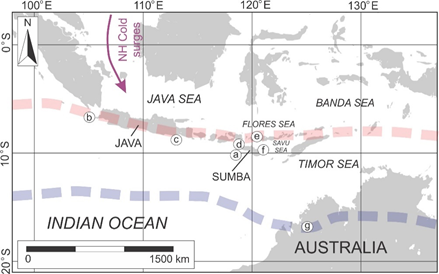Three drier periods (lower rainfall) (i.e., before ~17, ~1513.5, and 7–3 ka BP) and three wetter periods (higher rainfall) (i.e., ~17–15, ~13.5–7, and after ~3 ka BP) were detected on Southern Indonesia (off southwest Sumba) based on geochemical element (terrigenous input) proxies (ln Ti/Ca and K/Ca). During the Last Deglaciation, AISM rainfall responded to high latitude climatic events related to the latitudinal shifts of the austral summer ITCZ. Sea level rise, solar activity, and orbitally-induced insolation were most likely the primary driver of AISM rainfall changes during the Holocene, but the driving mechanisms behind the latitudinal shifts of the austral summer ITCZ during this period are not yet understood.
- paleoclimate
- Australian-Indonesian monsoon
- elemental ratio
- Southern Indonesia
During the Last Deglaciation, the rainfall changes were most likely connected to the high latitude climate events, i.e., early stage of Deglaciation (ED) (before ~17 ka BP), HS1 (~17–15 ka BP), ACR (~15–13.5 ka BP), and Younger Dryas (~13.5–11 ka BP) (Figure 1). Wetter periods coincided with the NH cold events (i.e., HS1 and YD) while drier periods indicated NH warm events (ED) and southern hemisphere (SH) cold events (ACR). Higher rainfall during HS1 and YD might be induced by the southward shift of the austral summer ITCZ while lower rainfall during ED and ACR were linked to the northward shift of the austral summer ITCZ [1][2] (Figure 2). The NH cooling (during HS1 and YD) enhanced the boreal winter cold surges, which pushed the ITCZ southward [1]. This mechanism also resulted in a southward shift of the boreal summer ITCZ, indicated by the lower EASM rainfall [3][4]. The lower rainfall during ACR could be explained by its co-occurrence with B-A [5] hence the northward shift of austral summer ITCZ was most likely linked to the NH warming (during ED and B-A) [1][6]. The Last Deglaciation rainfall records of ST08 were similar to d18O records from Bali Gown Cave (Northwestern Australia) [7] (Figure 1), indicating the southern boundary of the austral summer ITCZ during wetter periods (HS1 and YD) [1] (Figure 2). On the other hand, D18O (d18OGs.ruber−d18OG.bulloides) records (which indicated AIWM changes) from off south Java [1]and terrigenous input proxies (ln Ti/Ca) from off southwest Java [8] showed the opposite rainfall changes during the ACR (Figure 1). This indicated that the records from Java region responded to B-A instead, so they hinted a considerable influence of NH cross-equatorial moisture transport and the southern boundary of the austral summer ITCZ [8] (Figure 2).
Figure 1. Drier (yellow highlight) and wetter (green highlight) periods inferred from terrigenous input proxies (a,b)[9]. Other paleoclimate records are presented for comparison: (c). Terrigenous input proxy (ln Ti/Ca) record of GeoB10043-3 [8], (d). Terrigenous input proxy (ln Ti/Ca) record of GeoB10065-7 [10], (e). d18O record of stalagmites from Bali Gown cave (Northwestern Australia) [7], (f). d18O Globigerinides (Gs.) ruber–d18O Globigerina (G.) bulloides (D18O) record of GeoB10053-7 [11], (g). C30 n-alkanoic fatty acids d13C (d13CFA) record of GeoB10069-3 [12], (h). d18O record of Antarctic (EPICA Dronning Maud Land/EDML) ice core [13], (i). d18O record of Greenland (GISP2) ice core [14], (j). Reconstructed relative sea level from d18O of Red sea benthic foraminifera [15] [16], (k). 10-years averaged reconstructed sunspot numbers [17], and (l). 20° S Dec. (austral summer) insolation (red) and 30° N Jun. (boreal summer) (blue) [18]. Data are plotted against the mean ages obtained from the age model. Black curves indicate smoothed values (exponential smoothing, df: damping factor).
Figure 2. The southern limit of the austral summer ITCZ during the drier (lower rainfall) periods (red dashed line) and during the wetter (higher) rainfall periods (blue dashed line) as suggested by this study and other previous studies [1][2][9][19][20]. Numbers show the location of ST08 ((a), this study) and other studies used for comparison i.e., GeoB10043-3 (b) [8], GeoB10053-7 (c) [11], GeoB10065-7 (d) [10], Liang Luar cave (Flores) (e) [20], GeoB10069-3 (f) [12], and Bali Gown cave (Northwestern Australia) (g) [6].
The YD wetter period continued until Early Holocene (EH). The abrupt rainfall increase in EH, which was inferred in off southwest Java [8], not detected on ST08. This could be linked to the relatively constant terrigenous input in off southwest Sumba due to the considerable distance from the recently drowned-Sunda Shelf, as opposed to off southwest Java [8]. δ18O records on off south Java, which changes closely followed boreal summer insolation, increased during YD–EH [1] (Figure 1). This indicated the simultaneous increase of AISM and AIWM, but the effect of the strengthening AIWM and lower austral summer insolation (which should result in AISM weakening) was most likely distressed by the enhanced moisture supply related to abrupt sea-level rise [8][11][21](Figure 1).
During Mid-Holocene, the rainfall records of ST08 were similar to the ln Ti/Ca records from off northwest Sumba, which inferred drier (wetter) Mid (Late) Holocene [10] (Figure 1). Lower rainfall during the Mid Holocene (MH) (~7–3 ka BP) was most likely linked to the decrease in solar activity (hence lower sunspot numbers) [2][20], which suppressed the effect of increasing austral summer insolation [10][17]. During the Late Holocene (LH) (after ~3 ka BP), an increase in austral summer insolation and solar activity resulted in the enhancement of rainfall [10][18][17]. The southern boundary of the austral summer ITCZ during MH was most likely located around its position during ED and ACR [1,19,20] and shifted southward during LH to around its position during HS1, YD, and EH [1][10][19] (Figure 2), but their relation to solar activity and orbitally-induced austral summer insolation is still not understood [21]. The carbon isotope composition of the C30 n-alkanoic fatty acids (d13CFA) records from the southwestern Savu Sea [12] showed contradictive rainfall records (Figure 1). This contradiction might be related to the differences in climate signals recorded on terrigenous input and d13CFA proxies. d13CFA reflects the dry season (AIWM) water stress connected to the amount of rainfall during AIWM (AIWM rainfall) [12]. We suggest a joint analysis of terrigenous input and d13CFA proxies from the same site in future studies to reconstruct the past changes of both AISM and AIWM rainfall, so more robust AIM rainfall records are produced.
This entry is adapted from the peer-reviewed paper 10.3390/atmos11090932
References
- Wolfgang Kuhnt; Ann Holbourn; Jian Xu; Bradley Opdyke; Patrick De Deckker; Ursula Röhl; Manfred Mudelsee; Southern Hemisphere control on Australian monsoon variability during the late deglaciation and Holocene. Nature Communications 2015, 6, 5916, 10.1038/ncomms6916.
- Xuan Ding; F. Bassinot; F. Guichard; N.Q. Fang; Indonesian Throughflow and monsoon activity records in the Timor Sea since the last glacial maximum. Marine Micropaleontology 2013, 101, 115-126, 10.1016/j.marmicro.2013.02.003.
- Huayu Lu; Shuangwen Yi; Zhengyu Liu; Joseph A. Mason; Dabang Jiang; Jun Cheng; Thomas Stevens; Zhiwei Xu; Enlou Zhang; Liya Jin; et al. Variation of East Asian monsoon precipitation during the past 21 k.y. and potential CO2 forcing. Geology 2013, 41, 1023-1026, 10.1130/g34488.1.
- H.N. Wu; Y.Z. Ma; Z.-D. Feng; A.Z. Sun; C.J. Zhang; F. Li; J. Kuang; A high resolution record of vegetation and environmental variation through the last ∼25,000 years in the western part of the Chinese Loess Plateau. Palaeogeography, Palaeoclimatology, Palaeoecology 2009, 273, 191-199, 10.1016/j.palaeo.2008.12.023.
- Morgan. V.I.. Antarctic Cold Reversal In Encyclopedia of Paleoclimatology and Ancient Environments; Springer Netherlands: Dordrecht, 2009; pp. 22 - 24.
- R.F Denniston; Karl-Heinz Wyrwoll; Victor J. Polyak; Josephine R. Brown; Yemane Asmerom; Alan D. Wanamaker; Zachary Lapointe; Rebecca Ellerbroek; Michael Barthelmes; Daniel M. Cleary; et al. A Stalagmite record of Holocene Indonesian–Australian summer monsoon variability from the Australian tropics. Quaternary Science Reviews 2013, 78, 155-168, 10.1016/j.quascirev.2013.08.004.
- R.F Denniston; Karl-Heinz Wyrwoll; Yemane Asmerom; Victor J. Polyak; William F. Humphreys; John Cugley; David Woods; Zachary Lapointe; Julian Peota; Elizabeth Greaves; et al. North Atlantic forcing of millennial-scale Indo-Australian monsoon dynamics during the Last Glacial period. Quaternary Science Reviews 2013, 72, 159-168, 10.1016/j.quascirev.2013.04.012.
- R. Y. Setiawan; Mayhar Mohtadi; John Southon; Jeroen Groeneveld; Stephan Steinke; Dierk Hebbeln; The consequences of opening the Sunda Strait on the hydrography of the eastern tropical Indian Ocean. Paleoceanography 2015, 30, 1358-1372, 10.1002/2015pa002802.
- Ryan Dwi Wahyu Ardi; Aswan; Khoiril Anwar Maryunani; Eko Yulianto; Purna Sulastya Putra; Septriono Hari Nugroho; Istiana; Last Deglaciation—Holocene Australian-Indonesian Monsoon Rainfall Changes Off Southwest Sumba, Indonesia. Atmosphere 2020, 11, 932, 10.3390/atmos11090932.
- Stephan Steinke; Mayhar Mohtadi; Matthias Prange; Vidya Varma; Daniela Pittauerova; Helmut W. Fischer; Daniela Pittauer; Mid- to Late-Holocene Australian–Indonesian summer monsoon variability. Quaternary Science Reviews 2014, 93, 142-154, 10.1016/j.quascirev.2014.04.006.
- Mayhar Mohtadi; Delia W. Oppo; Stephan Steinke; Jan-Berend W. Stuut; Ricardo De Pol-Holz; Dierk Hebbeln; Andreas Lückge; Glacial to Holocene swings of the Australian–Indonesian monsoon. Nature Geoscience 2011, 4, 540-544, 10.1038/ngeo1209.
- Nathalie Dubois; Delia W. Oppo; Valier Galy; Mayhar Mohtadi; Sander Van Der Kaars; Jessica E. Tierney; Yair Rosenthal; Timothy I. Eglinton; Andreas Lückge; Braddock K. Linsley; et al. Indonesian vegetation response to changes in rainfall seasonality over the past 25,000 years. Nature Geoscience 2014, 7, 513-517, 10.1038/ngeo2182.
- EPICA Community Members; C. Barbante; J.-M. Barnola; Silvia Becagli; J. Beer; M. Bigler; C. Boutron; T. Blunier; E. Castellano; O. Cattani; et al. One-to-one coupling of glacial climate variability in Greenland and Antarctica. Nature 2006, 444, 195-198, 10.1038/nature05301.
- P. M. Grootes; M. Stuiver; Oxygen 18/16 variability in Greenland snow and ice with 10−3- to 105-year time resolution. Journal of Geophysical Research: Atmospheres 1997, 102, 26455-26470, 10.1029/97jc00880.
- Helge W. Arz; Frank Lamy; Andrey Ganopolski; Norbert Nowaczyk; Jürgen Pätzold; Dominant Northern Hemisphere climate control over millennial-scale glacial sea-level variability. Quaternary Science Reviews 2007, 26, 312-321, 10.1016/j.quascirev.2006.07.016.
- M. Siddall; Eelco J. Rohling; A. Almogi-Labin; Ch. Hemleben; D. Meischner; I. Schmelzer; David A. Smeed; Sea-level fluctuations during the last glacial cycle. Nature 2003, 423, 853-858, 10.1038/nature01690.
- Sami K. Solanki; I. G. Usoskin; B. Kromer; M. Schüssler; J. Beer; Unusual activity of the Sun during recent decades compared to the previous 11,000 years. Nature 2004, 431, 1084-1087, 10.1038/nature02995.
- Andrél. Berger; Long-Term Variations of Daily Insolation and Quaternary Climatic Changes. Journal of the Atmospheric Sciences 1978, 35, 2362-2367, 10.1175/1520-0469(1978)035<2362:ltvodi>2.0.co;2.
- Takeshige Ishiwa; Yusuke Yokoyama; Lars Reuning; Cecilia M. McHugh; David De Vleeschouwer; Stephen J. Gallagher; Australian Summer Monsoon variability in the past 14,000 years revealed by IODP Expedition 356 sediments. Progress in Earth and Planetary Science 2019, 6, 17, 10.1186/s40645-019-0262-5.
- Linda K. Ayliffe; Michael K. Gagan; Jian-Xin Zhao; Russell Drysdale; John Hellstrom; Wahyoe S. Hantoro; Michael L. Griffiths; Heather Scott-Gagan; Emma St Pierre; Joan A. Cowley; et al. Rapid interhemispheric climate links via the Australasian monsoon during the last deglaciation. Nature Communications 2013, 4, 2908, 10.1038/ncomms3908.
- Stephan Steinke; Matthias Prange; Christin Feist; Jeroen Groeneveld; Mayhar Mohtadi; Upwelling variability off southern Indonesia over the past two millennia. Geophysical Research Letters 2014, 41, 7684-7693, 10.1002/2014gl061450.


